THE HOUSE THAT PIETER BUILT –
Great traditional celebrations were held when after 8years, despite many trials, and tribulations, the building was complete
STEPPING OUT IN FAITH
Today, I want to tell you about a family that has inspired me, and also my family over many years, and about #thehousethatpieterbuilt which is the most interesting home, and well worth sharing with you as to how this was accomplished.
My husband was the Minister of the Presbyterian Church in Vryheid, in Northern Kwa-Zulu Natal and during that time he also conducted a service once a month at a small wood and iron Church which was owned by the Anglicans, but which they permitted us to use, in Paulpietersburg which is 53ks away from Vryheid.
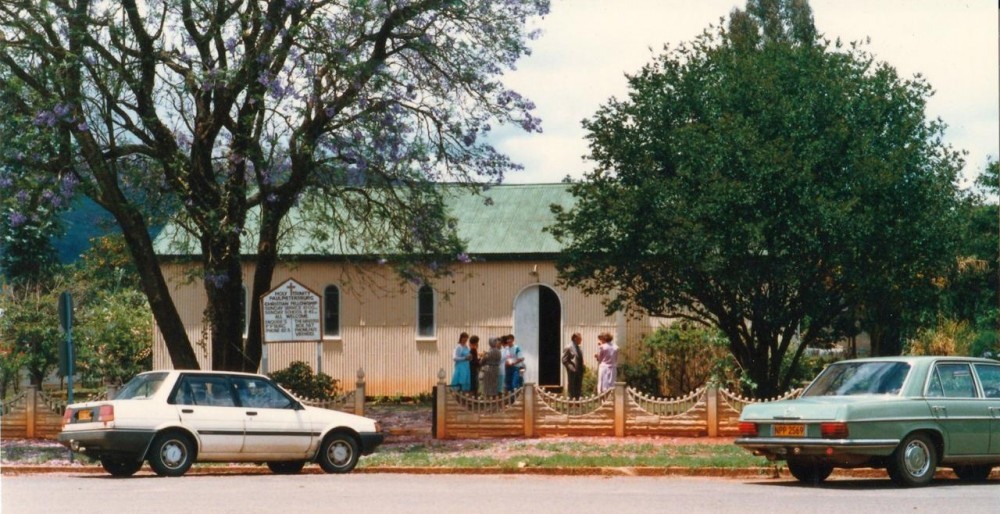 Among the worshipers in Paulpietersburg was Annemarie Wenning and four of her five children, the eldest daughter, Bonita, was working overseas at that time.
Among the worshipers in Paulpietersburg was Annemarie Wenning and four of her five children, the eldest daughter, Bonita, was working overseas at that time.
They live on the family farm, Emerald Acres, having moved there in 1974 in the Paulpietersburg district. As Annemarie’s husband, Pieter was not with her on that occasion, Matthew, being the good Pastor that he was, said not to worry he would call around at the farm soon and meet him.
One day during the following week, he did just that and found Pieter at the building site of the home he was starting to build. He and Annemarie had, as farmers do, paced it out and marked where they wanted the rooms to be and so on, and now the trenches were in the process of being dug.
When Matthew walked up to the site, wearing a traditional white safari suit, which was customary for the clergy and doctors to wear at that time, Pieter asked him, “What are you selling?”
“Oh, no”, Matthew replied, “I am not here to sell you anything but to give you a gift. This gift has already been paid in full, by the blood of Christ”.
Pieter was so taken aback by the reply because Matthew showed so much interest in the planning and the layout of the building and as he and Pieter walked around (in the mud) they discussed the building and, of course, the church.

Thus began a firm friendship that lasted until Pieter passed away many years later and we returned to Paulpietersburg for Matthew to conduct Pieter’s funeral which was held in the large Dutch Reformed Church, the little wood and iron church would never have held all the people who attended and came to pay their respects to the family.
Pieter and Annemarie Wennings’ farm has been in the family for generations and the family is very well known and loved in the area
The entire family attended worship each time Matthew preached in Paulpiettersburg and we more often than not had Sunday lunch with the Wennings at the farm.
When I was away on a trip to Kwa-Zulu Natal recently, my brother, Myles, kindly took me on a road trip to visit Annemarie, who with her eldest daughter Bonita, and her two sons, Guy and Dominick, are carrying on with the farming.
Staying with Annemarie is always such a pleasure and while there I asked her if she minded that I write about their farming endeavors and about the building of the house. She graciously said I could, so here goes.
PACING HOME SOIL FOR THE HOUSE THAT PIETER BUILT
The children were growing up, they needed more space, and the house they were living in didn’t suit their growing needs so they went ahead and planned the house of their dreams.
Knowing Pieter and Annemarie as I do, I can imagine that they planned this very carefully and as Pieter had artistic talents (inherited from his world-famous artist Grandfather, Pieter Wenning). He probably made a sketch of their combined ideas.
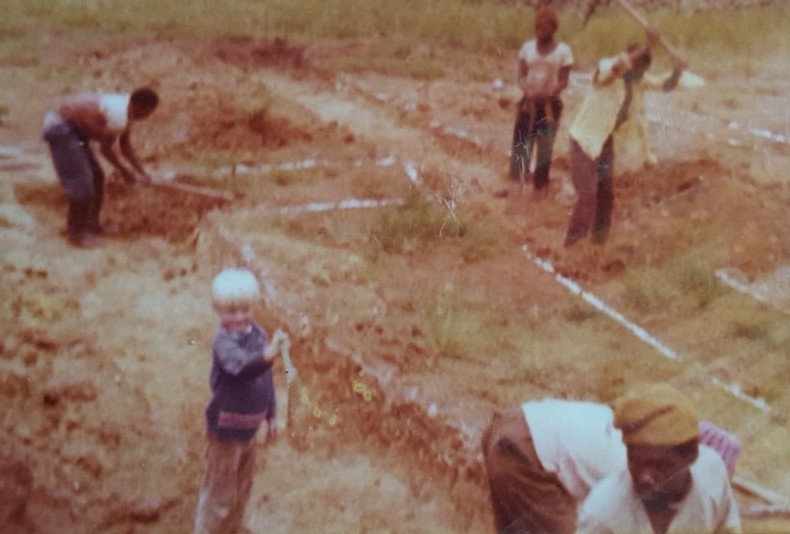
Something I do know is that they physically measured the rooms by pacing out the area designated for the building.
As with all buildings, when the trenches are dug, they always look smaller than the size will turn out, and so they kept adding on until they were both satisfied.
This method has resulted in an enormous home with generous rooms, with a unique character.
The house has 6 bedrooms, 4 bathrooms, an enormous main living area, a sewing room, laundry, a study, a games room, and a smaller, more intimate lounge in which the family could relax at their leisure. Underneath the kitchen area is the workshop and garage.
DIGGING THE TRENCHES THE HOUSE THAT PIETER BUILT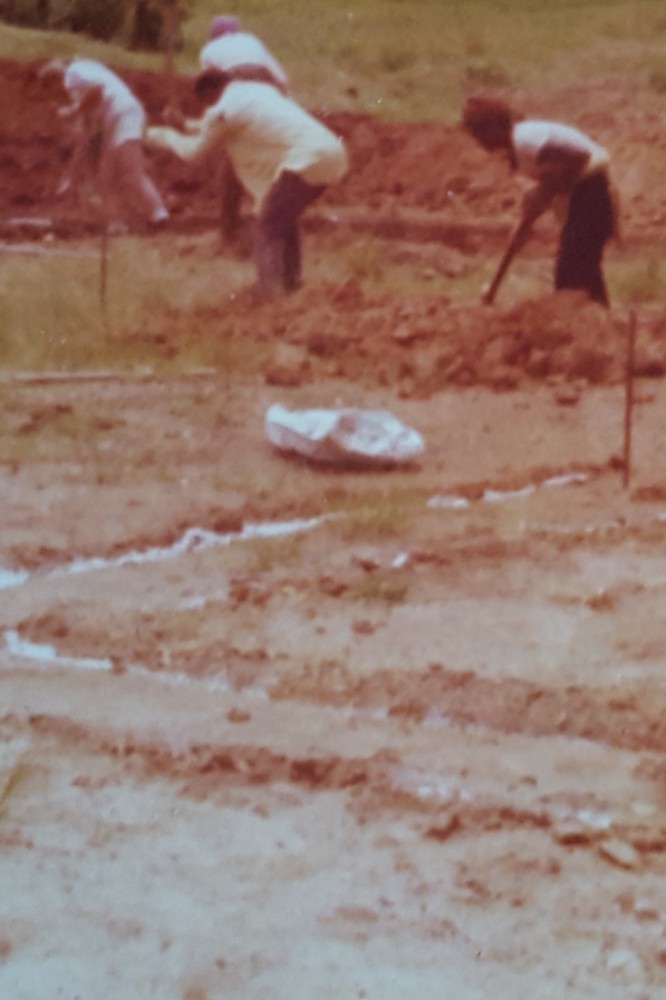
The digging of the trenches and removing soil to flatten out the top of the hill on which the house was built was a mammoth task and required a lot of time and effort on behalf of Pieter and his workers.
All the time this was happening, naturally, the work on the farm had to carry on.
Fortunately, as with all the Wenning family, Annemarie and Guy were not averse to hard work and besides helping with the trench digging, they carried on with the farming.
There were chickens to raise and sell. They had a butchery on the farm and this and the chickens were just a part of Annemarie’s many farming enterprises.
In fact, it was the raising of chickens since 1974 that kept the farm going for many a long year.
Very recently they stopped keeping chickens as feeding them has become extremely expensive and also it has become too dangerous to sell to cash buyers at the farm gate.
THROUGHOUT THE BUILDING OF THE HOUSE THAT PIETER BUILT FARMING KEPT GOING
Not only did the chickens need to be attended to but there were also the peach orchards to see to. Anyone who has ever had peach trees knows that a lot of work goes into fertilizing, watering, and pruning to keep them producing the best possible crop which would later be sold.
Another crop grown on the farm was radishes for feeding the herd of Gir cattle which were Pieter’s pride and joy. These were too precious to slaughter and only the old cattle and weaners were sold.
Pieter was so fond of his cattle and they would be brushed regularly.
The family, Annemarie, Guy, and the two younger daughters, Rosanna and Moya, who were weekly boarders and were only home at the weekends, managed to keep up with the farm chores.
Oh, dear, chores sound like easy things that people give their little children to do for pocket money to teach them the value of money, believe me when I tell you the work they all did, and still do, is what I would call, physical labor.
When they initially moved to the farm in 1974 Annemarie kept chickens which she continued to do until just recently – that is what kept the farm going throughout the bad times.
Unfortunately, it has become too dangerous to sell to cash buyers at the farm gate now, and with the feed so expensive, she has now given up keeping chickens.
MISFORTUNE AND TRAGEDY STRIKE THE HOUSE THAT PIETER BUILT
Due to difficulties beyond their control, building the house came to a standstill and took eight long years to complete.
In 1989 the entire farm burned out due to negligence by railway workers. The main railway line to Richards Bay runs right through the middle of the farm and trains with more than 100 trucks filled with coal go through there all the time.
The fire devastated the farm, the entire orchard was burned out,
They were kept waiting for many years for the case to be wound up and for the compensation to be paid for the fire damage.
This delay did not mean that background work was not being done regarding the building. There were umpteen things still to sort out, the least of which was the sourcing of the stone required for the cladding of the house, the slate for the flooring, and also finding a competent company to make the roof beams, which were enormous.
All the burned tree stumps had to be removed and the ground made ready for another crop. After a lot of investigating done by Annemarie through contact with the Department of Agriculture, they decided that the area in which they live would be suitable for growing oranges.
As their farm is organic, all the compost is made on the farm. This was made using the vegetation on the farm and also utilizing the worm compost generated by the millions of worms bought just for that purpose.
In 1990 they planted 40 hectares of orange trees
THE LONG HARD SLOG TO GET THE BUILD FINISHED
Can you just imagine how much work still needs to be done? The laying of the conduit for the electrical wiring had to be complete before the  concrete could be poured over them and then it all smoothed out.
concrete could be poured over them and then it all smoothed out.
Then it was time for the slate for the floors to be laid. This was done by two women and they did a wonderful job.
The slate was sourced in Rustenburg which is a long way off and sent by train and carefully unloaded at the siding and transported on the tractor-trailer to the building site.
Slate ships and breaks very easily so this had to be very carefully handled.
The lovely rose quartz, which is used for the cladding of the entire house, barring the front wall, was sourced in Luneberg and transported to the farm.
Luneberg is 35 kilometers away from Paulpietersburg and I think another approximately 10 kilometers from the farm.
The Red Jasper stone was found in the Pivaan River and also at Manzane on a Hillside.
Digging this from the hillside and the riverbed must have been another exhausting job but the effect this makes on the front wall of the building and also the enormous fireplace inside, is well worth all the effort.
Putting up the beams was one of Guy’s jobs and it took an entire day to put one up. There are 7 beams 24 meters long and 5 beams 16 meters long. They were so heavy and so unwieldy and the work was really dangerous as the building was extremely high.
All the woodwork on the ceiling was also done by Guy and the timber that was left was used to make the impressive workstation in the kitchen. Nothing was wasted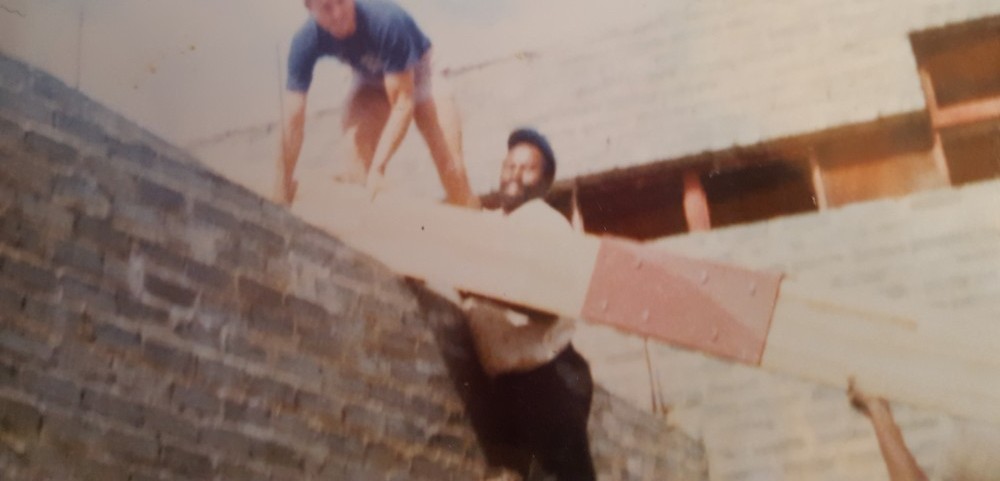
REWARDS AND CELEBRATION FOR ALL THOSE INVOLVED IN THE HOUSE THAT PIETER BUILT
What jubilation and celebration when the house was finished and the family moved in.
Once all the thanks had been said, the party was on.
The braai’s (barbecues) were smoking, the food set out and it must have been a huge relief to everyone, especially this amazing family and their workforce that this long-awaited day had come.

Everyone celebrated in their traditional ways. What a great day!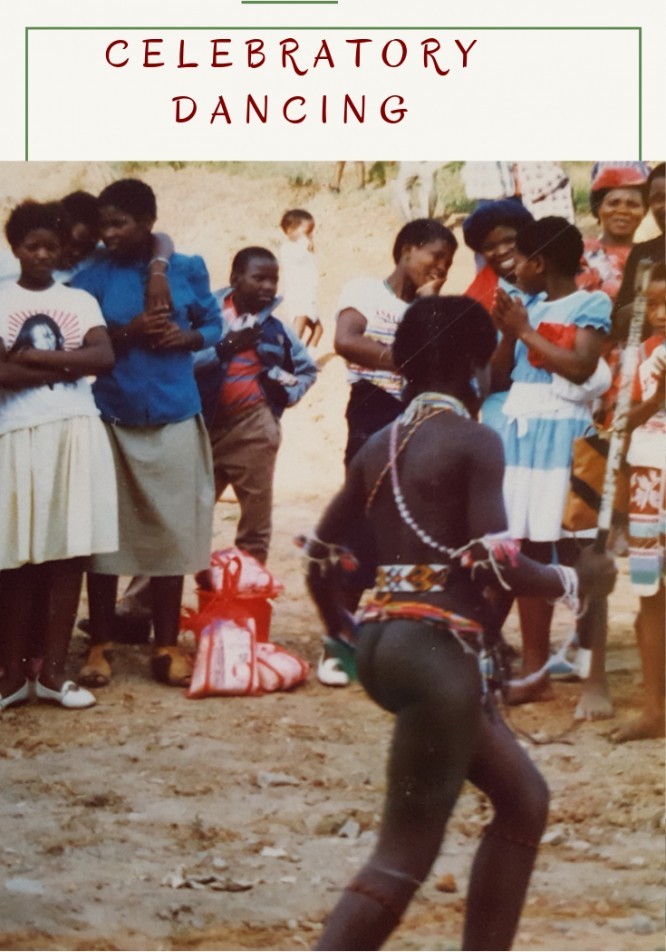

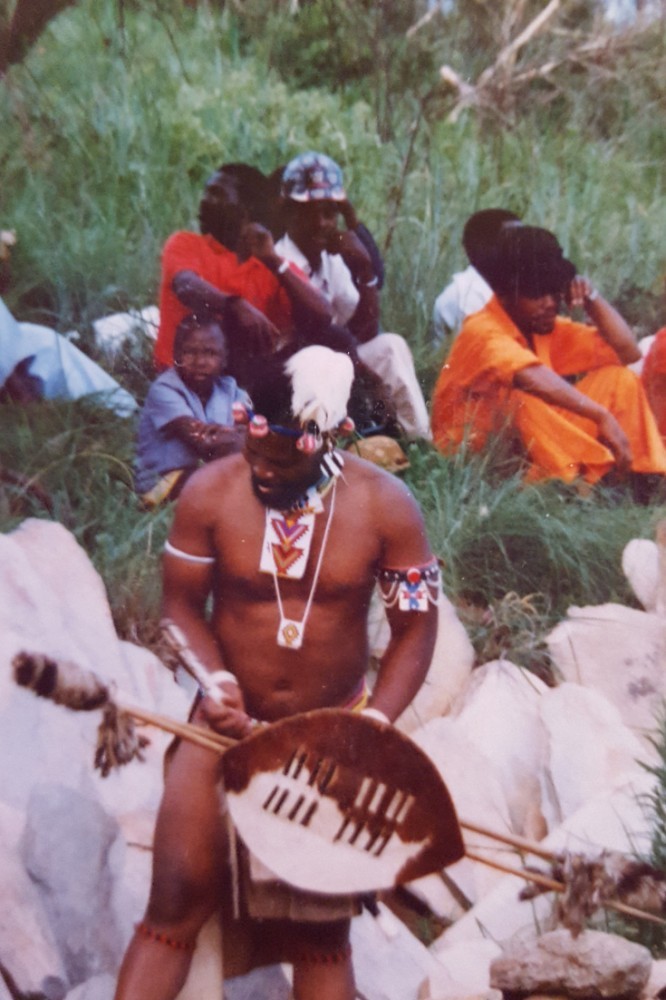
F

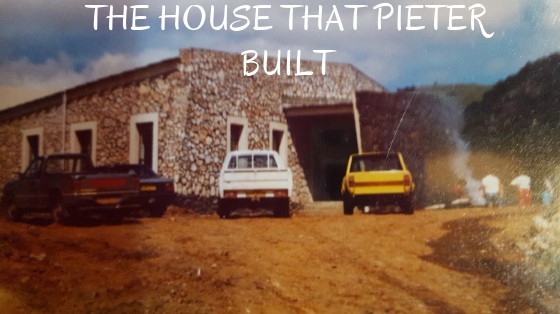
What a great story!
It has inspired me a lot. Despite all the difficulties and set back, they kept on working on the house. They did not lose focus on what they wanted to accomplish. And they finally made it without wasting any resources they had. I know how unreachable some places are in Africa, so I can only imagine how hard it was for the construction supply to reach the farm. Ans I appreciate their determination even more.
I think I need to learn how to stay focus and work toward my objectives despite all the misfortunes that can come my way.
Thanks for sharing.
Hi Adyns, Thank you for the great comments. It is so easy to give up on things and this story is a testament to the fortitude we can all find within ourselves and push on to succeed.
Wishing you all the very best,
Jill
What an inspiring story Jill! It makes me think the problems that I have are nothing compared to what this incredible family had to endure. What a testament to the human spirit to persevere and overcome their many difficulties to achieve their dream of build a home. God bless this family and God bless you and your husband for the work that you do.
Jack
Hi Jack, Thank you so much for such lovely comments on this post about my dear friends. They are the most remarkable family. I will shortly be writing a follow up about Annemarie and how she turned the farm around.
Sadly, my husband is now in frail care and does not recognize me anymore.
Such is life.
KInd regards,
Jill
Wow, Jill, I really enjoyed reading this story and it reminded me of my childhood weekends spend on our farm up in Hekpoort near Magaliesberg.
It is certainly no easy task running a farm and making a profit. My father tried many different things from proteas to mielies to fruit trees. Some made profits others didn’t. He also built onto an existing cottage four extra rooms in his spare time, and as a child, I still remember helping by carrying one brick at a time to the site.
Eventually, the farm got too much for my Dad to manage as it was weekends only so it was a sad day when he sold it and moved to Cape Town, but reading your story it brought back many amazing memories.
Hi Michel, Am so glad reading my post brought back happy memories of your childhood in Hekpoort for you.
I know Hekpoort well as we lived in Krugersdorp and had friends who had a farm out there.
Many thanks for reading my post and commenting.
All the best, Jill
Pieter is my cousin – we all called him Kolbe as there were quite a few Pieters and Peters in the Kolbe family already. My father had 10 siblings and Pieter’s mother Katie was one of my father’s sisters. Our family farm was on the Natal Spa road close to Zungwini station.
The house that Pieter built hosted many a family get together over Christmas; sometimes there were around 40 of us and what a time we all had. That home has many a story to tell
Hi Sue, Thank you for reading my blog about the house that Pieter built. I have written an email to you as I am not sure that you can read this reply.
We had so many good times at Emerald Acres with Pieter and Annemarie and have met so many of their relatives, so I am unsure whether or not you and I have met. If we have, I apologize for not remembering it. Kind regards, Jill